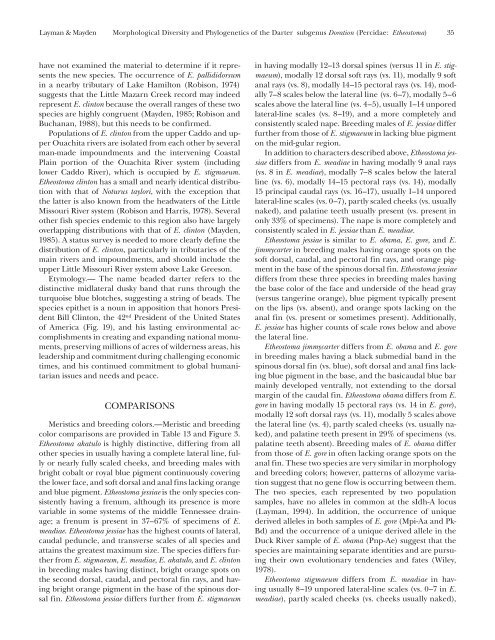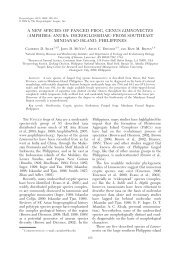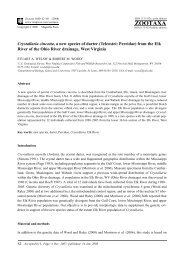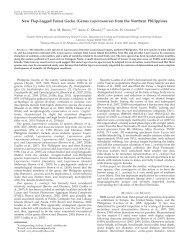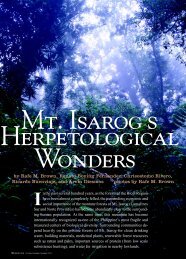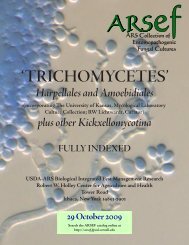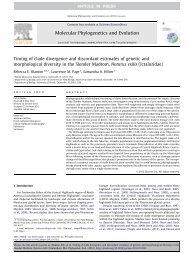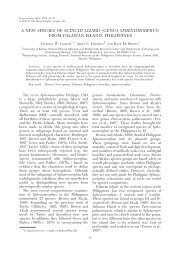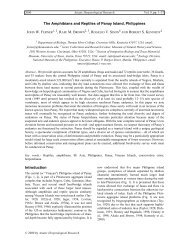(Percidae: Etheostoma), with Descriptions of Five New Species
(Percidae: Etheostoma), with Descriptions of Five New Species
(Percidae: Etheostoma), with Descriptions of Five New Species
- No tags were found...
You also want an ePaper? Increase the reach of your titles
YUMPU automatically turns print PDFs into web optimized ePapers that Google loves.
Layman & Mayden Morphological Diversity and Phylogenetics <strong>of</strong> the Darter subgenus Doration (<strong>Percidae</strong>: <strong>Etheostoma</strong>) 35have not examined the material to determine if it representsthe new species. The occurrence <strong>of</strong> E. pallididorsumin a nearby tributary <strong>of</strong> Lake Hamilton (Robison, 1974)suggests that the Little Mazarn Creek record may indeedrepresent E. clinton because the overall ranges <strong>of</strong> these twospecies are highly congruent (Mayden, 1985; Robison andBuchanan, 1988), but this needs to be confirmed.Populations <strong>of</strong> E. clinton from the upper Caddo and upperOuachita rivers are isolated from each other by severalman-made impoundments and the intervening CoastalPlain portion <strong>of</strong> the Ouachita River system (includinglower Caddo River), which is occupied by E. stigmaeum.<strong>Etheostoma</strong> clinton has a small and nearly identical distribution<strong>with</strong> that <strong>of</strong> Noturus taylori, <strong>with</strong> the exception thatthe latter is also known from the headwaters <strong>of</strong> the LittleMissouri River system (Robison and Harris, 1978). Severalother fish species endemic to this region also have largelyoverlapping distributions <strong>with</strong> that <strong>of</strong> E. clinton (Mayden,1985). A status survey is needed to more clearly define thedistribution <strong>of</strong> E. clinton, particularly in tributaries <strong>of</strong> themain rivers and impoundments, and should include theupper Little Missouri River system above Lake Greeson.Etymology.— The name beaded darter refers to thedistinctive midlateral dusky band that runs through theturquoise blue blotches, suggesting a string <strong>of</strong> beads. Thespecies epithet is a noun in apposition that honors PresidentBill Clinton, the 42 nd President <strong>of</strong> the United States<strong>of</strong> America (Fig. 19), and his lasting environmental accomplishmentsin creating and expanding national monuments,preserving millions <strong>of</strong> acres <strong>of</strong> wilderness areas, hisleadership and commitment during challenging economictimes, and his continued commitment to global humanitarianissues and needs and peace.COMPARISONSMeristics and breeding colors.—Meristic and breedingcolor comparisons are provided in Table 13 and Figure 3.<strong>Etheostoma</strong> akatulo is highly distinctive, differing from allother species in usually having a complete lateral line, fullyor nearly fully scaled cheeks, and breeding males <strong>with</strong>bright cobalt or royal blue pigment continuously coveringthe lower face, and s<strong>of</strong>t dorsal and anal fins lacking orangeand blue pigment. <strong>Etheostoma</strong> jessiae is the only species consistentlyhaving a frenum, although its presence is morevariable in some systems <strong>of</strong> the middle Tennessee drainage;a frenum is present in 37–67% <strong>of</strong> specimens <strong>of</strong> E.meadiae. <strong>Etheostoma</strong> jessiae has the highest counts <strong>of</strong> lateral,caudal peduncle, and transverse scales <strong>of</strong> all species andattains the greatest maximum size. The species differs furtherfrom E. stigmaeum, E. meadiae, E. akatulo, and E. clintonin breeding males having distinct, bright orange spots onthe second dorsal, caudal, and pectoral fin rays, and havingbright orange pigment in the base <strong>of</strong> the spinous dorsalfin. <strong>Etheostoma</strong> jessiae differs further from E. stigmaeumin having modally 12–13 dorsal spines (versus 11 in E. stigmaeum),modally 12 dorsal s<strong>of</strong>t rays (vs. 11), modally 9 s<strong>of</strong>tanal rays (vs. 8), modally 14–15 pectoral rays (vs. 14), modally7–8 scales below the lateral line (vs. 6–7), modally 5–6scales above the lateral line (vs. 4–5), usually 1–14 unporedlateral-line scales (vs. 8–19), and a more completely andconsistently scaled nape. Breeding males <strong>of</strong> E. jessiae differfurther from those <strong>of</strong> E. stigmaeum in lacking blue pigmenton the mid-gular region.In addition to characters described above, <strong>Etheostoma</strong> jessiaediffers from E. meadiae in having modally 9 anal rays(vs. 8 in E. meadiae), modally 7–8 scales below the lateralline (vs. 6), modally 14–15 pectoral rays (vs. 14), modally15 principal caudal rays (vs. 16–17), usually 1–14 unporedlateral-line scales (vs. 0–7), partly scaled cheeks (vs. usuallynaked), and palatine teeth usually present (vs. present inonly 33% <strong>of</strong> specimens). The nape is more completely andconsistently scaled in E. jessiae than E. meadiae.<strong>Etheostoma</strong> jessiae is similar to E. obama, E. gore, and E.jimmycarter in breeding males having orange spots on thes<strong>of</strong>t dorsal, caudal, and pectoral fin rays, and orange pigmentin the base <strong>of</strong> the spinous dorsal fin. <strong>Etheostoma</strong> jessiaediffers from these three species in breeding males havingthe base color <strong>of</strong> the face and underside <strong>of</strong> the head gray(versus tangerine orange), blue pigment typically presenton the lips (vs. absent), and orange spots lacking on theanal fin (vs. present or sometimes present). Additionally,E. jessiae has higher counts <strong>of</strong> scale rows below and abovethe lateral line.<strong>Etheostoma</strong> jimmycarter differs from E. obama and E. gorein breeding males having a black submedial band in thespinous dorsal fin (vs. blue), s<strong>of</strong>t dorsal and anal fins lackingblue pigment in the base, and the basicaudal blue barmainly developed ventrally, not extending to the dorsalmargin <strong>of</strong> the caudal fin. <strong>Etheostoma</strong> obama differs from E.gore in having modally 15 pectoral rays (vs. 14 in E. gore),modally 12 s<strong>of</strong>t dorsal rays (vs. 11), modally 5 scales abovethe lateral line (vs. 4), partly scaled cheeks (vs. usually naked),and palatine teeth present in 29% <strong>of</strong> specimens (vs.palatine teeth absent). Breeding males <strong>of</strong> E. obama differfrom those <strong>of</strong> E. gore in <strong>of</strong>ten lacking orange spots on theanal fin. These two species are very similar in morphologyand breeding colors; however, patterns <strong>of</strong> allozyme variationsuggest that no gene flow is occurring between them.The two species, each represented by two populationsamples, have no alleles in common at the sIdh-A locus(Layman, 1994). In addition, the occurrence <strong>of</strong> uniquederived alleles in both samples <strong>of</strong> E. gore (Mpi-Aa and Pk-Bd) and the occurrence <strong>of</strong> a unique derived allele in theDuck River sample <strong>of</strong> E. obama (Pnp-Ae) suggest that thespecies are maintaining separate identities and are pursuingtheir own evolutionary tendencies and fates (Wiley,1978).<strong>Etheostoma</strong> stigmaeum differs from E. meadiae in havingusually 8–19 unpored lateral-line scales (vs. 0–7 in E.meadiae), partly scaled cheeks (vs. cheeks usually naked),


